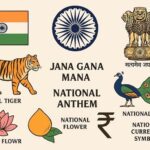National Symbols Of India
- 1. National Flag of India (Tiranga)
- 2. National Emblem of India
- 3. National Anthem – “Jana Gana Mana”
- 4. National Song – “Vande Mataram”
- 5. National Animal – Bengal Tiger (Panthera tigris tigris)
- 6. National Bird – Indian Peacock (Pavo cristatus)
- 7. National Flower – Lotus (Nelumbo nucifera)
- 8. National Tree – Banyan (Ficus benghalensis)
- 9. National Fruit – Mango (Mangifera indica)
- 10. National River – Ganga
- 11. National Currency – Indian Rupee (₹)
National Symbols of India, covering their history, significance, and societal importance in a human-friendly way:
1. National Flag of India (Tiranga)
Description: A horizontal tricolor of saffron, white, and green with the Ashoka Chakra (24-spoke navy blue wheel) in the center.
Adopted: 22nd July 1947
Significance:
Saffron: Courage and sacrifice
White: Peace and truth
Green: Prosperity and growth
Ashoka Chakra: Dharma (righteousness) and progress
Impact: Symbolizes unity in diversity and India’s struggle for independence. It instills patriotism and national pride.
2. National Emblem of India
Description: An adaptation of the Lion Capital of Ashoka at Sarnath, showing four lions standing back to back.
Adopted: 26th January 1950
Significance:
Represents power, courage, pride, and confidence.
Includes a horse, bull, Dharma Chakra, and the motto “Satyameva Jayate” (Truth Alone Triumphs).
Impact: Appears on currency, official documents, and government insignia, symbolizing governance and authority.
3. National Anthem – “Jana Gana Mana”
Written by: Rabindranath Tagore
Adopted: 24th January 1950
Significance: Inspires patriotism, unity, and love for the nation.
Impact: Sung at official events, schools, and sports matches, instilling national pride.
4. National Song – “Vande Mataram”
Written by: Bankim Chandra Chatterjee
Significance: Represents devotion to the motherland and was a source of inspiration during India’s freedom struggle.
Impact: Recited during cultural and national celebrations, symbolizing patriotism.
5. National Animal – Bengal Tiger (Panthera tigris tigris)
Significance: Symbol of strength, agility, and grace.
Impact: Represents India’s rich wildlife heritage and conservation efforts (e.g., Project Tiger).
6. National Bird – Indian Peacock (Pavo cristatus)
Significance: Symbolizes beauty, elegance, and pride.
Impact: Appears in art, folklore, and cultural traditions across India.
7. National Flower – Lotus (Nelumbo nucifera)
Significance: Represents purity, spiritual awakening, and resilience.
Impact: Commonly used in religious rituals, art, and as a cultural emblem.
8. National Tree – Banyan (Ficus benghalensis)
Significance: Symbolizes longevity, unity, and wisdom.
Impact: Provides shelter and is associated with heritage, community gatherings, and Indian folklore.
9. National Fruit – Mango (Mangifera indica)
Significance: Symbol of sweetness, prosperity, and cultural pride.
Impact: Widely cultivated, used in festivals, cuisine, and rituals.
10. National River – Ganga
Significance: Symbolizes purity, spirituality, and life-giving energy.
Impact: Provides water for millions, supports agriculture, and plays a central role in religious practices.
11. National Currency – Indian Rupee (₹)
Symbol: ₹
Significance: Represents economic sovereignty and national identity.
Impact: Used daily in commerce, trade, and official transactions.
Conclusion
India’s national symbols reflect the country’s rich heritage, diversity, and core values. From the flag and emblem that inspire patriotism, to the Bengal tiger and peacock symbolizing natural strength and beauty, each symbol carries profound meaning. They unify citizens, instill pride, and preserve India’s cultural, ecological, and historical legacy for future generations.








